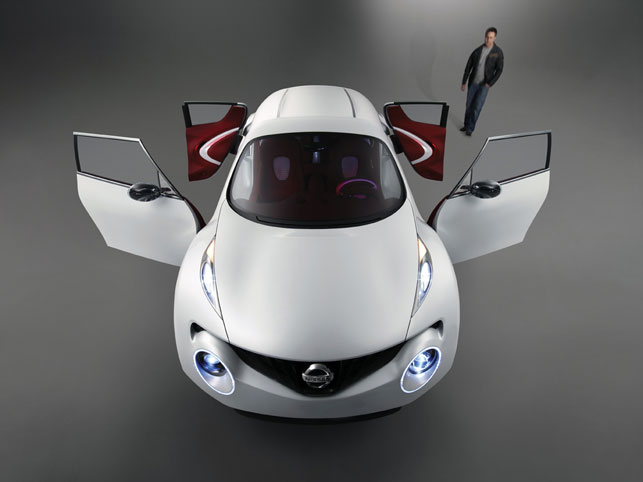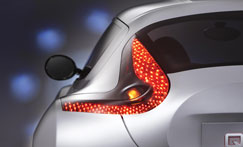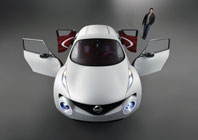Diversity is something Paragon RT thrives on, as the Darlington-based rapid prototyping bureau continues to seek out new ways and means to meet the needs of its customers.
As the economy falters, the company is looking to stand out from the crowd by increasing the range of services it offers, adding new materials and by working very closely with customers to identify new solutions to their problems.

The Nissan Qazana took centre stage at the recent Geneva Motor show and this would not have been possible without the help of Paragon RT, who manufactured almost all of the exterior “plastic” parts
“We add value with our technical support and our innovation,” says Darren Webb, business development manager. “Our innovation is one of our strengths. We already offer a lot of solutions but with research and development we are continually expanding our processes and materials.

Front grille:
The full width grille is an interpretation of current Nissan styling, but this grille is a one piece clear epoxy casting, produced from a CNC master and silicone tooling. The ribs on the back are fully visible through the clear polished front face, creating an optical illusion of depth and form.
Front lights:
Fully CNC machined cans and lenses, painted and polished with vacuum metalised reflectors. The light source is a combination of superbrite LEDs around a luxion star for the main beam and a flexible LED array for the ‘halo’ side lights
“We’re not the type of company to just say ‘that’s the limitations of the process, that’s what you’re going to get’, we always strive to exceed the perceived limitations. Many of our customers come to us with specific requirements, whether it’s chemical resistance or a specific technical issue with a project. We’ll go away and do some research, trial new materials and prepare samples.”
This dedication and ability to seek out new processes has seen customers coming back with further work and more intricate ideas.
“We have worked closely with some of our most innovative customers and in many cases they’ve jointly funded R&D projects with us. There’s an obvious benefit for them to have a working prototype but there’s also a benefit for us if we can identify and add new services,” says Darren. “Many of our new processes, finishing techniques and materials are a result of these successful R&D projects and now our customers have the confidence that nine times out of ten we can rise to the challenge.”
“We’ve proven that this approach helps build relationships and that’s why our customers come back to us time and time again. We work very closely together, more like a partnership, rather than just another link in a supply chain.”
Silicone science
Paragon specialises in stereolithography, product finishing, vacuum casting and silicone tooling. Most recently though it has been developing processes for the production of silicone prototypes, a service for which it has created its own dedicated department to mix specialist blends and to improve processing by avoiding contamination.

Wheels: The individual spokes of the “alloy wheels” were produced as PU vacuum castings from SL masters and silicone tools, painted a metallic graphite colour and assembled to an aluminium hub and steel rim, giving the illusion of a robust, cast alloy
“We’ve adapted the vacuum casting process, applied what we’ve learnt from tooling and moulding, and now we’re producing parts in silicone,” continues Darren. “Initially they were quite simple parts such as keypads and seals, but now we produce some really complex mouldings such as full face respirators, and twin shot silicones and foams. There are very few other companies that would consider these projects.”
This has also opened up new opportunities in the health sector and a recent project with Touch Bionics drew on Paragon’s expertise in materials technology to develop a silicone-based transparent skin for a prosthetic hand.
Road tested
Paragon’s most high-profile customers come from the automotive sector and scattered around the workshops are all manner of parts, most of which are for high quality, low run projects. These are commissioned for life-size concept cars, such as the latest Nissan Qazana displayed at the Geneva motor show.
“It’s always exciting working on concept vehicles, but as always Nissan and CGi push the boundaries of innovation and we in turn have had to expand our processes and techniques, investing in research and design to come up with a solution,” explains Darren.

Rear lights: These innovative lamp units were machined from ABS, vacuum metalised and lacquered. The lenses were machined from acrylic with the internal lens tinted red with lacquer and the external lens smoked. The illumination is via optical fibres with a single central light source. The fibres feed up through a loom with 127 individual strands per side, emitting through custom made tubular holders to position the light just below the surface of the lens
In addition to concept projects, Paragon’s parts also find their way into production and the company has carried out work for luxury cars, which are produced in low numbers.
Building for the future
The business has recently focussed resources on increasing the size of the projects it can handle. An extension chamber for the vacuum casting machines has allowed it to manufacture components up to 1.7m in a single form. Elsewhere an extension to the building allows for vehicles to be driven inside and worked on directly, while also creating a space for confidential projects, which is essential when the company has competitors using its services concurrently.
Finding business between all the various market fluctuations seems to have allowed Paragon to sweep through the credit crunch relatively unscathed. By working to its strengths and expanding its range of services, the risk of diversity is paying off.
The car
The Qazana is the latest concept vehicle from Japanese car giant Nissan.
A baby brother of Nissan’s Qashqai, already in production, the Qazana is a study into how a small car of the future could look, taking cues from SUV and sports car styling. However, unlike most motorshow concepts nearly 75 per cent of this car should make it onto Britain’s roads next year.
The car took centre stage at the recent Geneva Motor show and this would not have been possible without the help of Paragon RT, who manufactured almost all of the exterior “plastic” parts.

For Paragon Rapid Technologies the risk of diversity is paying off






